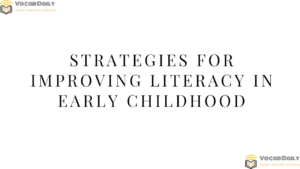Strategies for Improving Literacy in Early Childhood
Early childhood is a critical period for literacy development. Laying a strong foundation during these formative years sets the stage for lifelong learning and academic success. This article explores effective strategies for improving literacy in young children, emphasizing actionable steps and practical solutions.
The Importance of Early Literacy Exposure
Exposure to language and literacy-rich environments is vital for young children. Research shows that early exposure to books, storytelling, and conversations fosters language development and vocabulary growth. Creating a home environment filled with diverse reading materials and engaging children in daily reading routines strengthens their understanding of language structure and meaning.
Early literacy exposure also includes playful interactions, such as singing nursery rhymes, which introduce rhythm, phonemic awareness, and rhyme recognition. These activities make literacy enjoyable, helping children associate reading with positive experiences.
Parental Engagement in Literacy Activities
Parents play a pivotal role in developing their child’s literacy skills. Reading aloud is one of the most effective methods, as it models fluency, pronunciation, and expression. Parents can enhance this experience by asking open-ended questions about the story, encouraging critical thinking and comprehension.
Incorporating literacy into daily routines, such as reading recipe instructions or creating shopping lists, fosters practical literacy skills. Encouraging children to “read” environmental print, like street signs or labels, integrates literacy into everyday life.
Interactive and Hands-On Learning
Interactive activities captivate young learners and reinforce literacy concepts. Letter recognition games, such as matching letters to objects or tracing letters in sand, build foundational skills. Storytime with props or puppets transforms reading into a multisensory experience, deepening comprehension and engagement.
Using hands-on tools like magnetic letters or alphabet puzzles enhances fine motor skills and promotes letter familiarity. Activities that integrate play, such as pretend writing or drawing, encourage creativity while fostering literacy development.
The Role of Educators in Early Literacy
Educators are instrumental in creating structured learning experiences tailored to individual needs. A well-designed curriculum that includes phonics, vocabulary building, and storytelling fosters holistic literacy development. Teachers can employ strategies like shared reading, where children participate in reading activities collectively, to build confidence and fluency.
Small group instruction allows educators to address specific literacy challenges and provide personalized guidance. Creating a print-rich classroom environment with labeled objects, word walls, and diverse books encourages independent exploration and reinforces literacy concepts.
Technology as a Tool for Literacy Development
Modern technology offers innovative resources for enhancing early literacy. Interactive e-books, educational apps, and online games make learning engaging and accessible. These tools often include audio features that help children connect spoken words with written text, improving fluency and comprehension.
However, screen time should be balanced with traditional literacy activities to ensure holistic development. Parents and educators should select high-quality digital content aligned with educational goals to maximize its benefits.
For more resources and tools to support early literacy development, visit VocabDaily. Don’t forget to explore the VocabDaily Workbook for practical exercises and activities that reinforce reading skills in young learners.


Leave a Reply